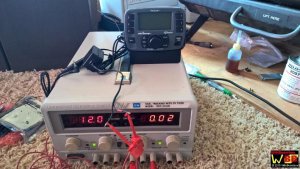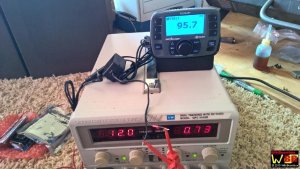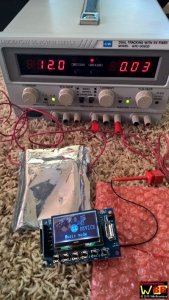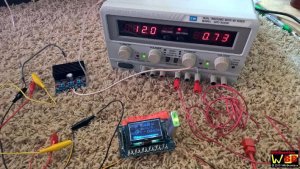All right, next up is the amp module itself. This is the one I'm using. Supposed to be 50W x2. Well, we will see. Here it is connected with no input signal. Looks like quiescent current is about 40mA. Not bad. If you left the boombox on with D cells and forgot to turn it off but either at idle or very low output, it would drain the boombox in about 210 hours or almost 9 days.
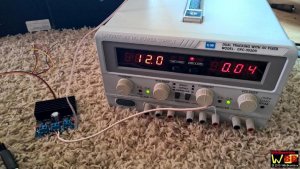
To test the power output, I had it hooked up like this:
On the left is my fluke used to measure the audio signal to be injected for source audio. The thing about music is that it jumps all over the place and you can't really measure since the reading is so unstable. I had it set up at 1khz and about 730mV. This is over 50% higher than the "standard consumer line-in" of -10db or about 447mV. Since we are stress testing the amp, why not push it, right?
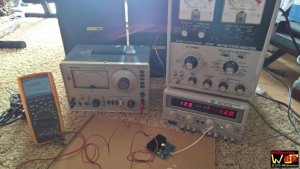
The analyzer above the power supply will be used to measure the power output in watts. I have it set to 8-ohms. I did not bother to test at 4-ohms. We can presume that output will be higher than the measurements obtained at 8-ohm impedance loads.
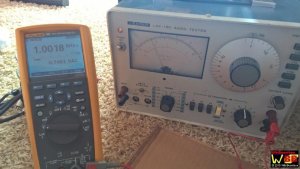
At 12V to the amp, I was reading about 12wpc RMS. Increasing the voltage to 16 volts results in output readings of 20wpc. Pushing the amp further, I increased voltage to 18 volts and got 26wpc rms x2. Remember that this is with input signal strength higher than one would normally feed it. Although it's possible to inject this much input power and more via MP3 or external CD's with headphone outputs, I am guessing that this would lead to clipped and distorted output. In fact, distortion is audible when input levels are pumped near max output from my iPhone into the amp. Because I'm all about audio quality and not distorted sound, I would not operate the boombox that way, although it's clear that the amp does have enough juice to produce lots of output, even if it IS distorted.
Reading output, 30w left, 26w right, 100w scale so reading x10.
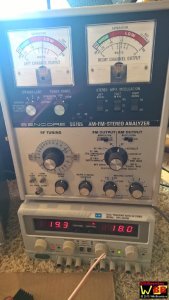
Further notes:
I tried to increase the input voltage to 1v @ 1khz, but the amp shut down. It is unclear whether the amps internal protection kicked in, or whether the PS (this I suspect) could not provide the juice needed and over-current protection kicked in. In fact, initially, I thought that I had blown the amp. I found out later that it was not fried. Speaking of which.... this amp is pretty durable. At one point, I tried to connect speaker leads with the unit powered up. No input at the time, but with the screw connectors, it should not have been a problem.. I only inserted one wire first (other end wasn't even connected to anything) and as soon as I started tightening the screw, smoke began to appear. Apparently, either the wire curled inside and touched the other pad or the terminal block itself twisted enough to short. I immediately removed the wire and checked. Again, I thought that the amp was fried. It was not and survived that momentary short. I knew it was risky and took the risk for convenience of time purposes (I had a spare amp available just in case). Still, this amp does seem quite durable. Luckily there was no input otherwise the end result might've been way different.
As for distortion, that was something I am interested in. Unfortunately, my Leader distortion meter turned out to be dead. Ah well, another bugger thing to add to my work queue. So what to do... Ok, I figured I would just scope the darn thing. By comparing input signal to output signal, I should be able to crank until I just see distortion or clipping, then register the input level it would take for that to happen. Simple right? Well, turns out not quite. Although I could get good readings on the input from the audio generator, the output looked all weird. Since the output waveform was not a clear sinewave, it was a bit hard to tell when exactly distortion occurred with the sinewave. Then it hit me. This isn't a class AB amp, it's a class D amp. Unlike standard analog amplifiers that amplifies EVERYTHING and outputs a carbon copy (albeit bigger), these digital amps chops up the audio signal and outputs it via PWM (pulse width modulate). No wonder the output looked all screwy compared to the audio signal input. Although the ears hear it as normal sound, the scope shows the signal much differently. Now, some people love class D/T amps. But to me, let's just say I can hear the difference and prefer the smoother sound quality of the class AB's. Well, anyhow, these class D's are much more efficient and the difference is not a deal breaker, especially for a boombox. Heck, we aren't talking HiFi McIntosh stuff here. It's gonna be a boombox!
Ok, while hooked up to an audio program, I watched the scope waveform and observed flattening out of the waveforms at various peaks and valleys when output was high. By increasing the voltage incrementally, the flattening was reduced. Normally, I would call these flattened areas clipping. However, once again, as we are talking about PWM output, this may just be longer dwell time on the pulse signal. The audio at the time did not sound "distorted" like one would hear during actual clipping in a standard class AB amp. While all of this is interesting, I think I've concluded that for the purposes of this project, I'm not going to worry about clipping and just use common sense. Distorted sound? Back it down a bit.
Now, to wait for more toys to come. Stay tuned. Lots of modules left to complete this. Once everything is in-hand, then comes time to construct a multi-rail power supply setup.






